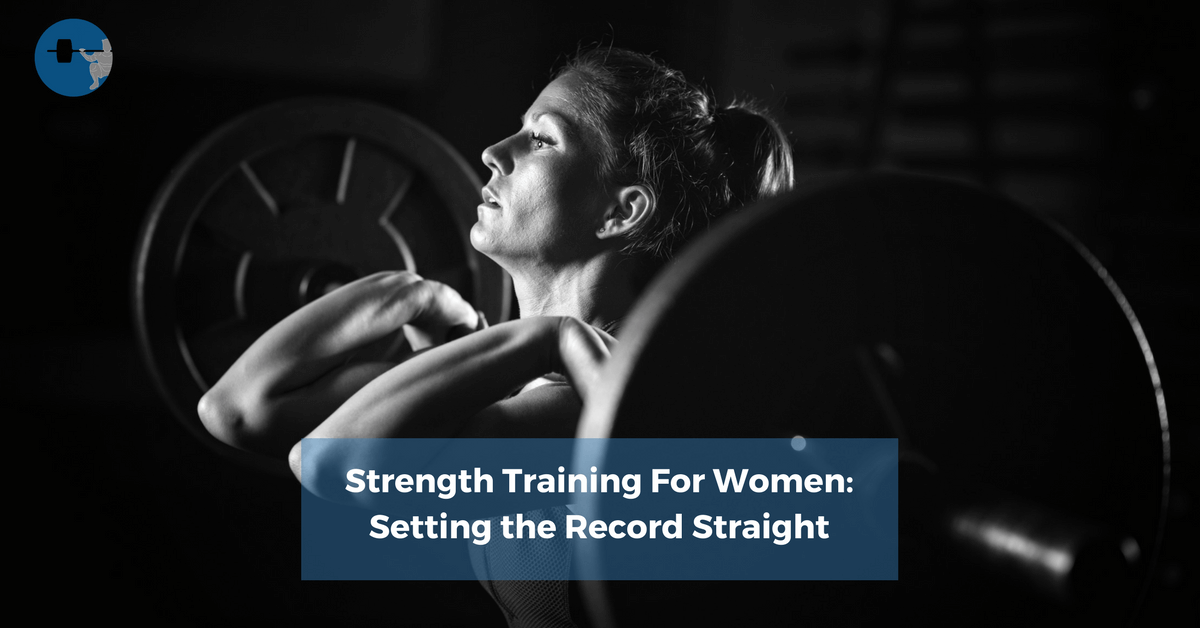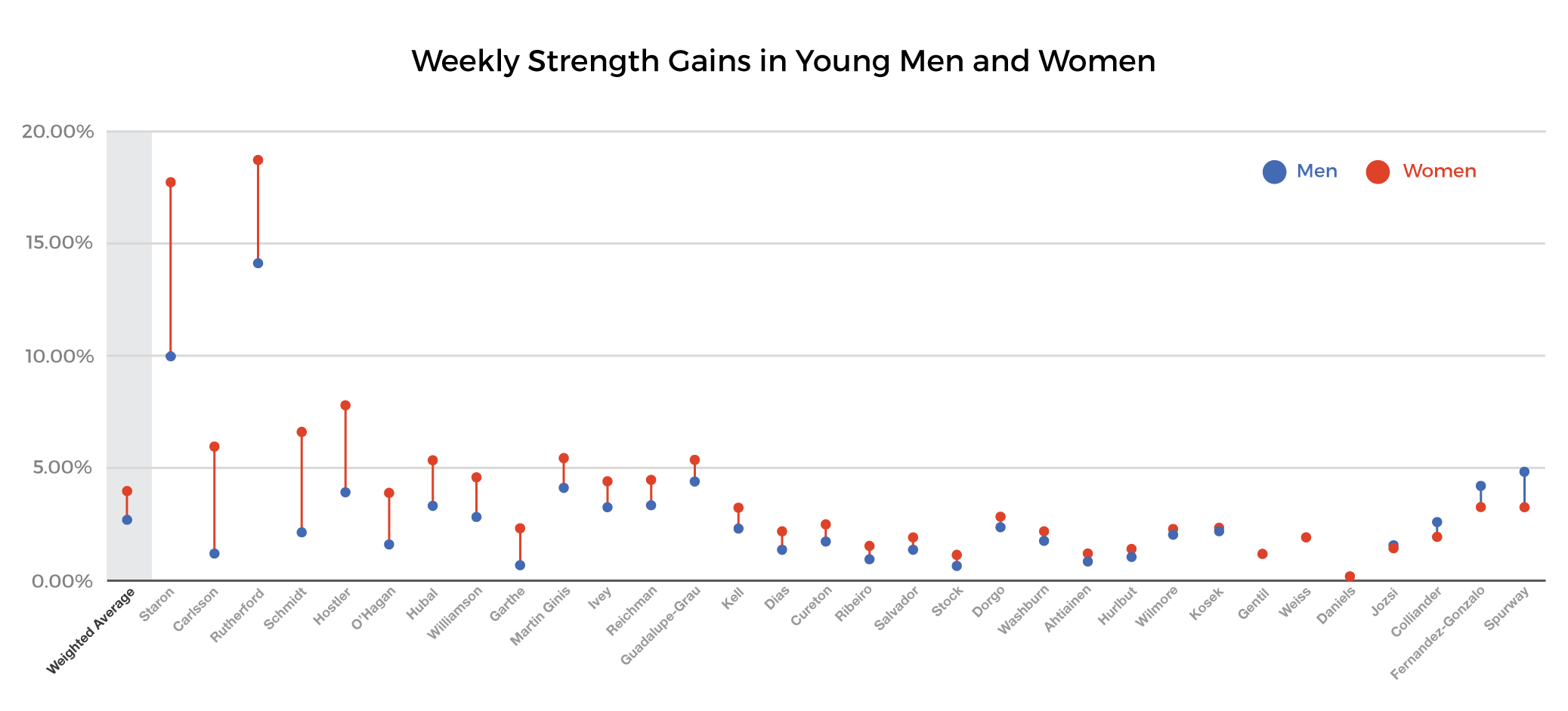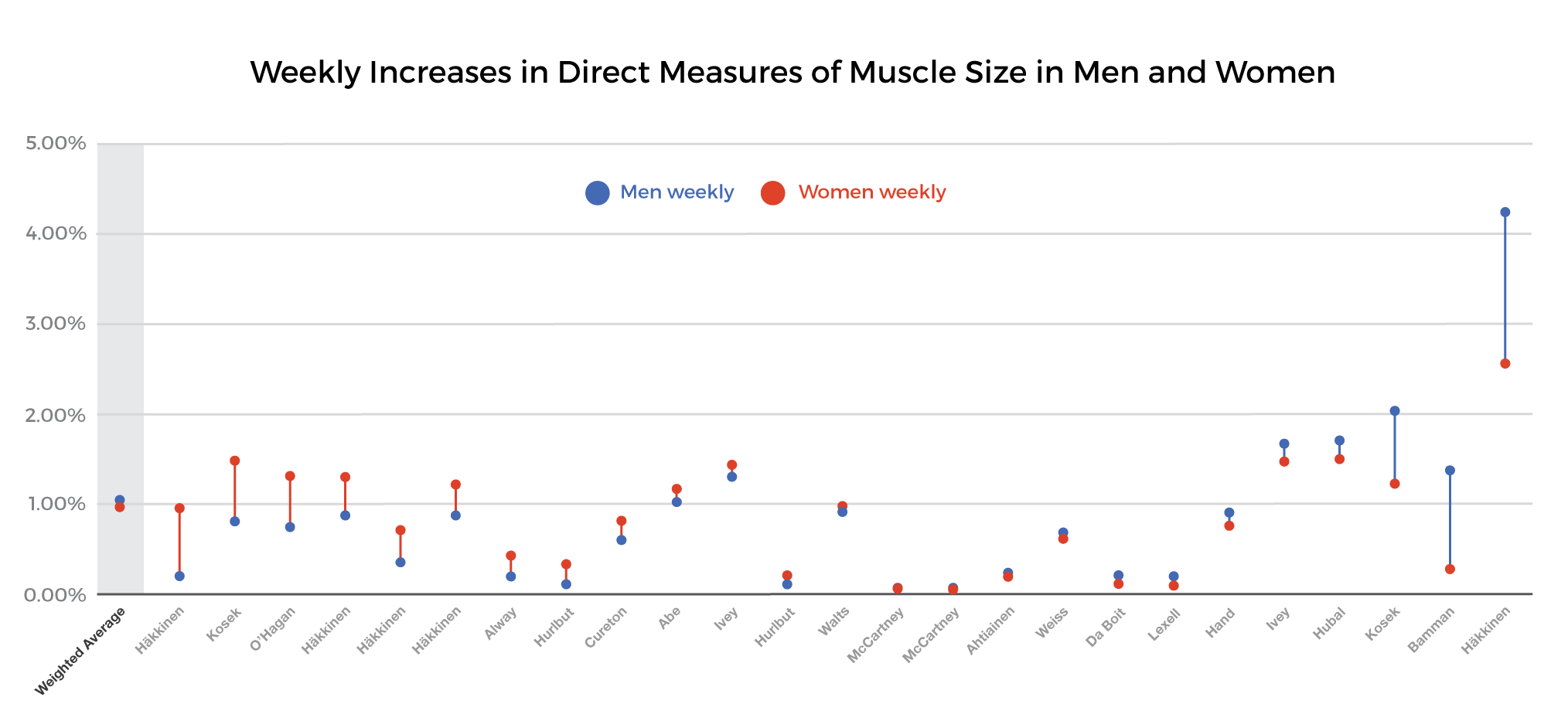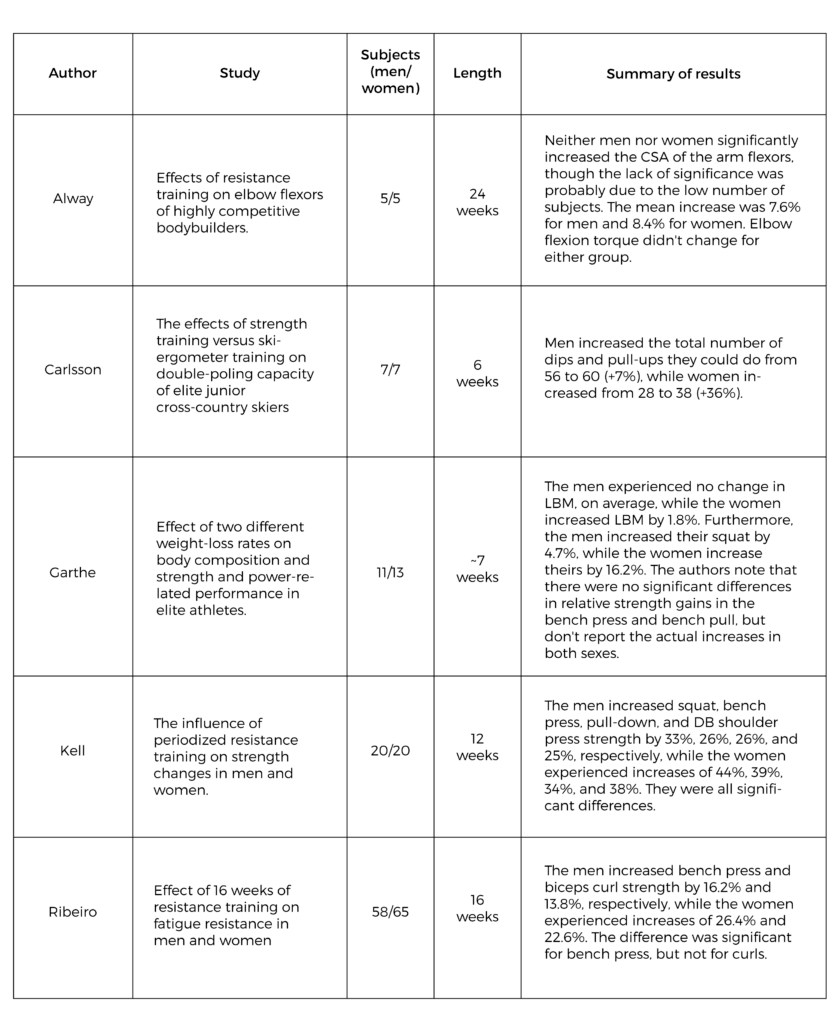There are a lot of misconceptions about strength training for women, and there are a lot of reasons for those misconceptions. Women are less likely to be represented in exercise research, women are less likely to take part in strength training or compete in strength sports, and there are still a lot of societal biases against women lifting (heavy) weights.
With that in mind, there are two general camps when it comes to strength training for women:
- The first camp says women and men are very different, respond to training very differently, and therefore women should ignore general strength training advice and only focus on advice specifically marketed as being “for women.” This camp is divided into two sub-camps.
- Some people claim that men will respond way better to training and that women’s results will be quite meager in comparison. This is a pretty standard “bro” position.
- Other people argue that bad things will happen to women if they lift heavy. They’ll either get hurt or get “too bulky,” so lifting heavy weights should be left to the men. This is a pretty standard position in a lot of women’s fitness magazines.
- As a semi-reactionary response to the first camp, a second camp contends that men and women are basically the same, respond to training in basically the same ways, and that training programs or expected training outcomes shouldn’t be at all influenced by sex.
Both groups, incidentally, tend to be heavy on narrative and light on research. What I want to do in this article is present the research comparing and contrasting male and female strength training. My goals with this article are to:
- Inform people (women specifically, but also coaches of both sexes) about the similarities and differences between men and women when it comes to strength training responses since there’s so much misinformation on the topic.
- Encourage more women to lift weights. Lifting is beneficial for damn near everyone, but for women especially, lifting weights can improve self-esteem and self-efficacy and can help dramatically with decreasing osteoporosis risk later in life.
With that out of the way, this article is going to start with a review of the research comparing strength and muscle growth in men and women. After that, I’ll focus just on the research using participants with prior training experience, and then I’ll review the inferences we can draw from sex differences in strength sports. At the end, I’ll discuss some other sex differences and female-specific considerations beyond rates of strength gains and muscle growth.
What you're getting yourself into:
5000 words, 17-35 minute read time
Key points:
1) While men start with more muscle mass and strength, relative strength gains actually tend to be larger in women, at least in the short term. This is especially true for younger women and upper body strength gains.
2) Long-term, relative rates of muscle growth and strength gains are probably roughly equal for men and women, though women may make slightly larger gains, relative to their starting point, across their entire training career.
3) Women are not just "little men." While relative muscle and strength gains may be similar, there are key differences between men and women that impact training and recovery.
Comparison of strength gains and muscle growth
Men are, in the vast majority of cases, both stronger and more muscular than women. They also gain both strength and muscle mass at a higher absolute rate. That much is obvious. However, relative rates of muscle growth and strength gains are, I think, the more interesting comparison since we largely tend to compare our progress to our own starting points. If a man gets 10% stronger in response to training, can a woman also expect to get 10% stronger after training, or should she instead expect to gain strength at a faster or slower relative rate?
Most of the time, there are meta-analyses to answer questions like this. A meta-analysis is essentially a “study of studies,” pooling the results from many different (smaller) research projects to make some sort of comparison. Meta-analyses are useful because individual studies may have skewed results, and a single study can’t possibly hope to answer every facet of a general research question like “how do relative gains in strength and muscle mass differ between men and women?” (What if they used different exercises? What if they used different training programs? What if they manipulated diet differently? What if they used people in a different age range? What if the study lasted twice as long? etc.)
Strangely, however, I couldn’t find a meta-analysis comparing strength gains and muscle growth in men and women. I say “strangely” because there are meta-analyses covering damn near every facet of strength training under the sun. Typically, once there are around a dozen studies on a given topic, someone’s going to do a meta-analysis. However, there have been 70+ studies comparing strength gains and muscle growth in men and women over the past 44 years, and no meta-analyses.
So…I did one. If you’re interested in the technical notes, you can find them here. In the results below, a positive number in a comparison means larger gains for women, while a negative number means larger gains for men.
Studies included in the analysis
Findings
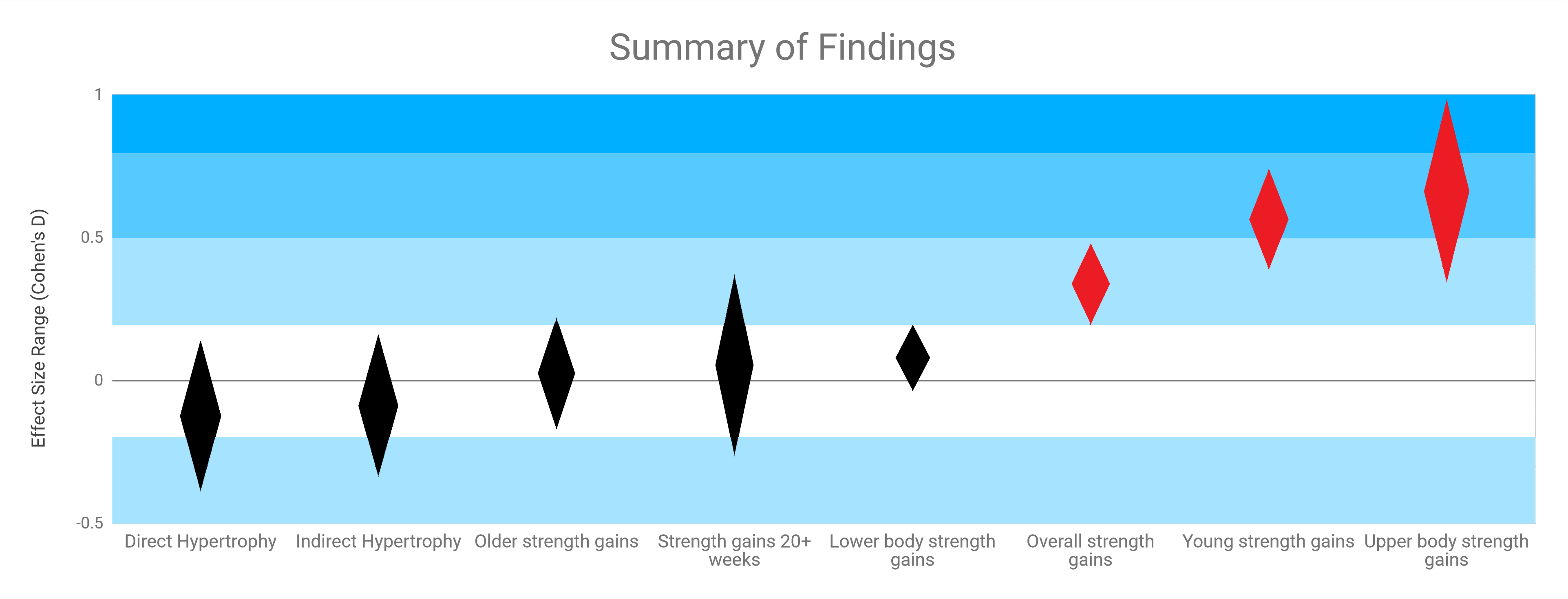
Overall strength gains
There were 63 comparisons of strength gains, encompassing 3,332 subjects. In these studies, men got 29.41% stronger, on average, while women got 37.42% stronger. The average difference was 8.01%, with a 95% confidence interval from 4.59-11.43%. This was a significant difference (p<0.0001) and would be considered a small effect (d=0.34; 95% CI: 0.19-0.48). On average, strength increased about 27% faster in women.
Strength gains in young (<35 years old) people
There were 32 comparisons of strength gains in young people, encompassing 1,745 subjects. In these studies, men got 30.87% stronger, on average, while women got 45.71% stronger. The average difference was 14.84%, with a 95% confidence interval from 10.26-19.42%. This was a significant difference (p<0.0001) and would be considered a medium effect (d=0.56; 95% CI: 0.39-0.74). On average, strength increased about 48% faster in young women.
Strength gains in older people
There were 31 comparisons of strength gains in older people, encompassing 1,587 subjects. In these studies, men got 27.80% stronger, on average, while women got 28.30% stronger. The average difference was 0.50%, with a 95% confidence interval from -3.11-4.11%. This was not a significant difference (p=0.79).
Upper body strength gains
There were 27 comparisons of upper body strength gains, encompassing 1,599 subjects. In these studies, men got 34.92% stronger, on average, while women got 47.51% stronger. The average difference was 12.59%, with a 95% confidence interval from 6.45-18.73%. This was a significant difference (p=0.0002) and would be considered a medium effect (d=0.66; 95% CI: 0.34-0.98). On average, upper body strength increased about 36% faster in women.
Lower body strength gains
There were 53 comparisons of lower body strength gains, encompassing 2,287 subjects. In these studies, men got 28.47% stronger, on average, while women got 30.64% stronger. The average difference was 2.17%, with a 95% confidence interval from -0.92-5.26%. This was nearly a significant difference (p=0.087), but probably isn’t practically relevant and would be considered a trivial effect (d=0.08; 95% CI: -0.03-0.19).
Strength gains in studies lasting 20+ weeks
There were 20 comparisons of strength gains in studies lasting 20+ weeks, encompassing 927 subjects. In these studies, men got 28.91% stronger, on average, while women got 29.91% stronger. The average difference was 1.00%, with a 95% confidence interval from -5.04-7.03%. This was not a significant difference (p=0.75).
Indirect measures of muscle growth
There were 28 comparisons of indirect measures of muscle growth (i.e. lean body mass), encompassing 1,607 subjects. In these studies, men increased measures of lean mass by 2.03%, on average, while women increased measures of lean mass by 1.92%. The average difference was -0.11%, with a 95% confidence interval from -0.40-0.19%. This was not a significant difference (p=0.47).
Direct measures of muscle growth
There were 25 comparisons of direct measures of muscle growth, encompassing 1,664 subjects. In these studies, men’s muscles grew 13.21%, on average, while women’s grew 12.24%. The average difference was -0.97%, with a 95% confidence interval from -3.02-1.08%. This was not a significant difference (p=0.36).
It wasn’t worth splitting apart the young and older subjects to do formal subgroup analyses for hypertrophy outcomes (I like having at least 20 studies to pool), but just looking at simple averages, it seems that men and women gain muscle at a similar rate regardless of age. In the studies on young participants (N=8), the men increased muscle size by 13.1%, while the women increased muscle size by 14.1%. Similarly, in the studies on older participants (N=17), the men increased muscle size by 11.9%, while the women increased muscle size by 11.8%. Both of these differences are clearly trivial.
Limitations
The main limitation of this analysis was that most of these studies were performed on untrained participants. In fact, only 5 of these studies were done on trained subjects. There aren’t enough studies on trained subjects to meta-analyze, but we can examine them individually below.
Another limitation is that, in studies on untrained subjects, we can’t necessarily assume that their backgrounds are identical prior to the start of a study. In other words, it’s possible that the “untrained” men in these studies had previously undertaken more activities outside the gym that required high levels of muscular exertion than the “untrained” women. If that were the case, you’d expect women to have faster initial relative strength gains simply from catching up with the male baseline.
That’s why I included the analysis of studies lasting 20+ weeks, to specifically look at studies where that sort of effect wouldn’t influence the results as much. That’s also why I separated upper body and lower body strength gains, as I’d expect this type of effect would be more prevalent for upper body strength than lower body strength. In support of the hypothesis that “untrained” women may be more untrained than “untrained” men – especially when it comes to upper body strength – women gained strength faster than men in shorter studies but not longer studies, and in measures of upper body strength but not lower body strength.
Trained subjects
Here are the main results from the five studies on trained subjects:
As such, we basically have no good research telling us about rates of muscle growth in trained men and women. My hunch is that relative rates of muscle growth will continue to be similar, but we’ll have to wait on further research to say for sure.As you can see, only one of these studies (Alway et al.) reported a direct measure of hypertrophy, and only one (Garthe et al.) reported an indirect measure of hypertrophy. Alway et al. is hampered by a very small sample, while Garthe et al. has a couple other confounding factors – 1) the main purpose of the study was to compare different rates of weight loss, so while the groups with differing rates of weight loss had similar numbers of men and women, it’s possible that group allocation affected results and 2) the study included athletes from many different sporting backgrounds, so while all of them did have prior training experience, it’s possible that the women were somewhat less trained than the men.
However, it’s clear from these studies that relative rates of strength gains seem to be somewhat higher in trained women than trained men. One study reported no significant differences, while the other four reported at least one significant difference in favor of women, and none in favor of men.
With that being said, it’s certainly possible that there were differences in real-world training status that are basically impossible for a study to account for. For example, if the men tended to train like hardcore powerlifters or bodybuilders, and the women tended to do the sort of lighter, higher-rep “toning” workouts that are often recommended to women, it would make sense that the women would gain strength faster. In other words, “research tends to indicate that trained women still gain strength quicker than trained men, but I’m concerned those studies are hampered by methodological limitations, so I’ll continue to assume the null (similar relative rates of strength gains) until research on a more representative population is conducted” is also a very defensible position.
To go a little deeper, we can look at powerlifting meet results to see how the gap between men and women shifts when comparing less competitive lifters to more competitive lifters. As mentioned in a previous article, women lift about 67% as much as men in the squat, 56% in the bench, and 71% in the deadlift, on average (using allometric scaling to correct for differences in body mass). However, those gaps are larger when looking at less successful lifters (those in the 10th percentile of relative strength) and smaller when looking at more successful lifters (those in the 90th percentile of relative strength). A 5th percentile woman has about 62% as much relative strength as a 5th percentile man in the squat, 53% in the bench, and 67% in the deadlift. On the other hand, a 95th percentile woman has about 71% as much relative strength as a 95th percentile man in the squat, 60% in the bench, and 75% in the deadlift. An analysis of weightlifting results in CrossFitters had similar findings (though they didn’t correct for differences in body mass): larger sex gaps in snatch and clean & jerk performance in lower-level lifters and smaller gaps in higher-level lifters.
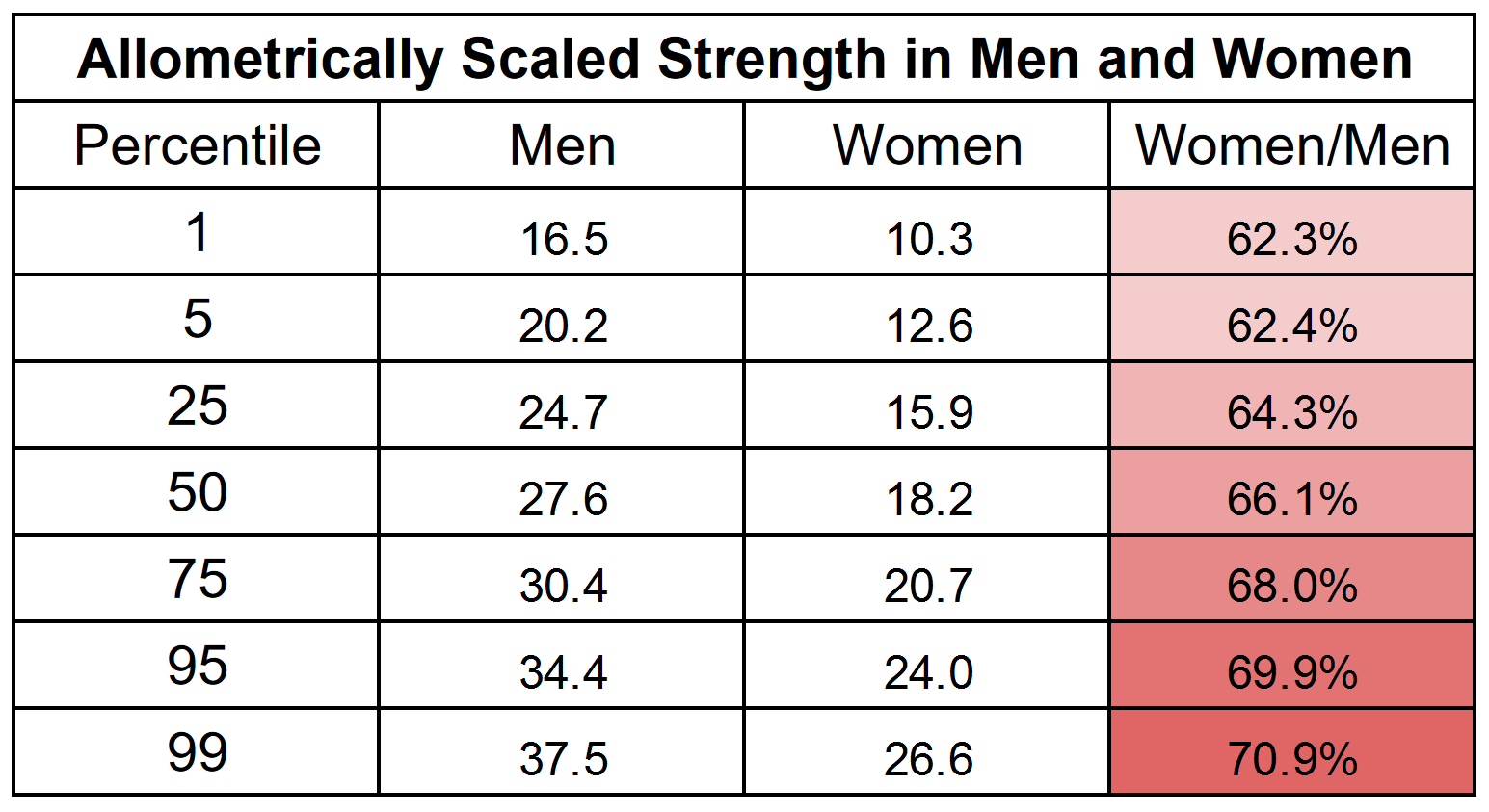
The narrowing of the gap as competitiveness increases suggests that women may truly continue gaining strength at a slightly faster relative rate across their training careers. Similarly, a 2014 study of elite athletes in a variety of sports found that the women had about 85% as much lean body mass as men; before training, women tend to have ~60-70% as much lean body mass as men, suggesting that women may actually gain relatively more muscle than men long-term (though, for all of these comparisons, you can’t assume causation from cross-sectional analyses).
So, just to wrap up this section, here are the big takeaways:
- Relative rates of muscle growth in men and women are virtually identical.
- Relative rates of strength gains are at least equal between sexes, though possibly faster in women.
- Especially during the first few months of training, relative rates of upper body strength gains are probably considerably higher in women than in men.
- Long-term, relative rates of strength gains may be slightly higher in women. However, if a difference exists, it’s likely very small.
Strength Training for Women – Discussion
I’m sure there are some people in a state of mild disbelief as this point. After all, men have more testosterone, and testosterone is anabolic; therefore, men should be at a huge advantage when it comes to building muscle and gaining strength, right? An implication of this analysis is that, assuming a given woman and a given man start with similar amounts of muscle mass and strength, they’d be likely to gain the same amount of muscle and strength if they both started lifting. That just doesn’t sit right with some people.
However, the role of testosterone may be overstated. My friend James Kreiger recently published a super thorough analysis (note: paywall, but totally worth it) on all things testosterone and muscle growth, including analyses of cross-sectional research on people with different testosterone levels, studies comparing men and women, studies where people are given exogenous testosterone, and even studies where people were put on drugs to totally suppress testosterone production. The main takeaway was that testosterone levels can dramatically affect the amount of muscle you start with, but they don’t really impact relative rates of muscle growth.
To quote James, “Variations in your blood levels of testosterone impact your ‘base’ level of muscle, but have minimal impact on your relative (%) gains. Thus, having higher testosterone levels means having a higher base level of muscle. While the relative gains will be mostly similar, the absolute gains will be higher due to the higher baseline.”
That’s very much in line with this analysis: Men start off with more muscle and more strength, largely due to higher testosterone levels, and absolute muscle and strength gains are larger because they started with a higher baseline. However, relative muscle gains are identical between sexes, and relative strength gains are likely similar long-term.
Also note, testosterone isn’t the only relevant sex difference here. There are sex differences in gene expression, sex differences in other anabolic hormones like IGF-1 (which may play a bigger role in women than men), and, obviously, sex differences in estrogen (which, contrary to popular belief, exerts anabolic effects in muscle tissue). Testosterone is only one piece of a much larger picture that only gets more confusing and convoluted the more you look at it. At the end of the day, it’s best to just remember the messiness of physiology and understand that outcomes (similar relative muscle growth and strength gains, supported by heaps of research) trump mechanisms (differences in testosterone levels) every time.
Other Female-Specific Considerations
If you’ll harken back to the beginning of this article, you’ll recall the two camps I mentioned: 1) people who claim that the process and outcomes of strength training for men and women are really dissimilar, and 2) people who claim that the process and outcomes of strength training for men and women are basically identical. As I’m sure you’ve figured out by now, I think that the people in the second camp are closer to the truth than the people in the first camp. However, I think they miss the mark to some degree as well, since there are sex differences that extend beyond average results.
For starters, women tend to be less acutely fatigable than men, meaning they can generally do more reps per set at a given percentage of 1RM, do more sets with a fixed number of reps at a given percentage of 1RM, or both. There are several factors underpinning this difference, but the two most important seem to be a) women tend to have a higher proportion of type I muscle fibers, which are more fatigue-resistant and b) women tend to have less muscle mass, so they don’t occlude blood vessels quite as quickly when lifting, meaning they can more efficiently deliver oxygen and clear metabolic waste products from their muscles. (However, I’ll note that this isn’t a unanimous finding).
Second, women may recover from training a bit faster than men (one, two, three). When I’ve mentioned this in the past, the counterargument I typically hear is that women don’t create as much force, so of course their muscles won’t sustain as much damage, and will therefore recover faster. However, that doesn’t make much sense when you think about it. For starters, I’m not aware of any evidence showing that people who are stronger or more muscular at baseline experience more muscle damage, more soreness, or larger/longer performance decrements than people who are weaker or less muscular, all else being equal. More importantly, what each of your muscle fibers “feel” is the tension on that specific fiber; the contractile force of the entire muscle shouldn’t matter, as long as each fiber is being recruited to a similar degree and experiencing a similar amount of tension. I think the more likely explanation is that estrogen may exert a protective effect on muscle, limiting damage and potentially accelerating repair.
Third, men and women may respond differently to low-load training. At this point, there’s a tremendous amount of evidence showing that low-load training (i.e. sets of 20+ reps) can build muscle just as effectively as heavier training (though just because you can build muscle effectively with low-load training, that doesn’t mean you should). However, only one of the studies comparing high-load and low-load training was done with women. It found that women training with higher loads (6-10RM loads) gained way more muscle than women training with lower loads (20-30RM loads). This stands in stark contrast to similar studies performed on men, suggesting that women may respond to normal, heavy-ish training the same way men do (mostly doing sets of 5-15 reps), but may not respond as well to low-load training.
Finally, women also have to deal with the menstrual cycle (women taking hormonal contraceptives can probably ignore this paragraph). There’s some evidence that women’s response to training varies based on menstrual cycle phase. For starters, it takes women longer to recover from training during the luteal phase (last half) of the menstrual cycle. Building on that, several studies (one, two, three) show that concentrating your training during the follicular phase (first half of the cycle) can lead to larger strength gains and more muscle growth than concentrating your training during the luteal phase or evenly dispersing it across the entire month. On a more practical level, it’s probably not wise to use an extreme program like the ones used in those studies (for example, training 3-5 times per week during the follicular phase, and only once per week during the luteal phase), but it’s possible that you can increase your progress in the gym while minimizing overtraining risk by adding an extra workout or two per week during the follicular phase. For example, if you normally train three times per week, every week, you could probably keep training three times per week during the luteal phase, but increase your frequency to four or five times per week during the follicular phase. This would help you take advantage of faster recovery rates and reap the benefits of the larger strength gains and enhanced muscle growth that occur during the follicular phase.
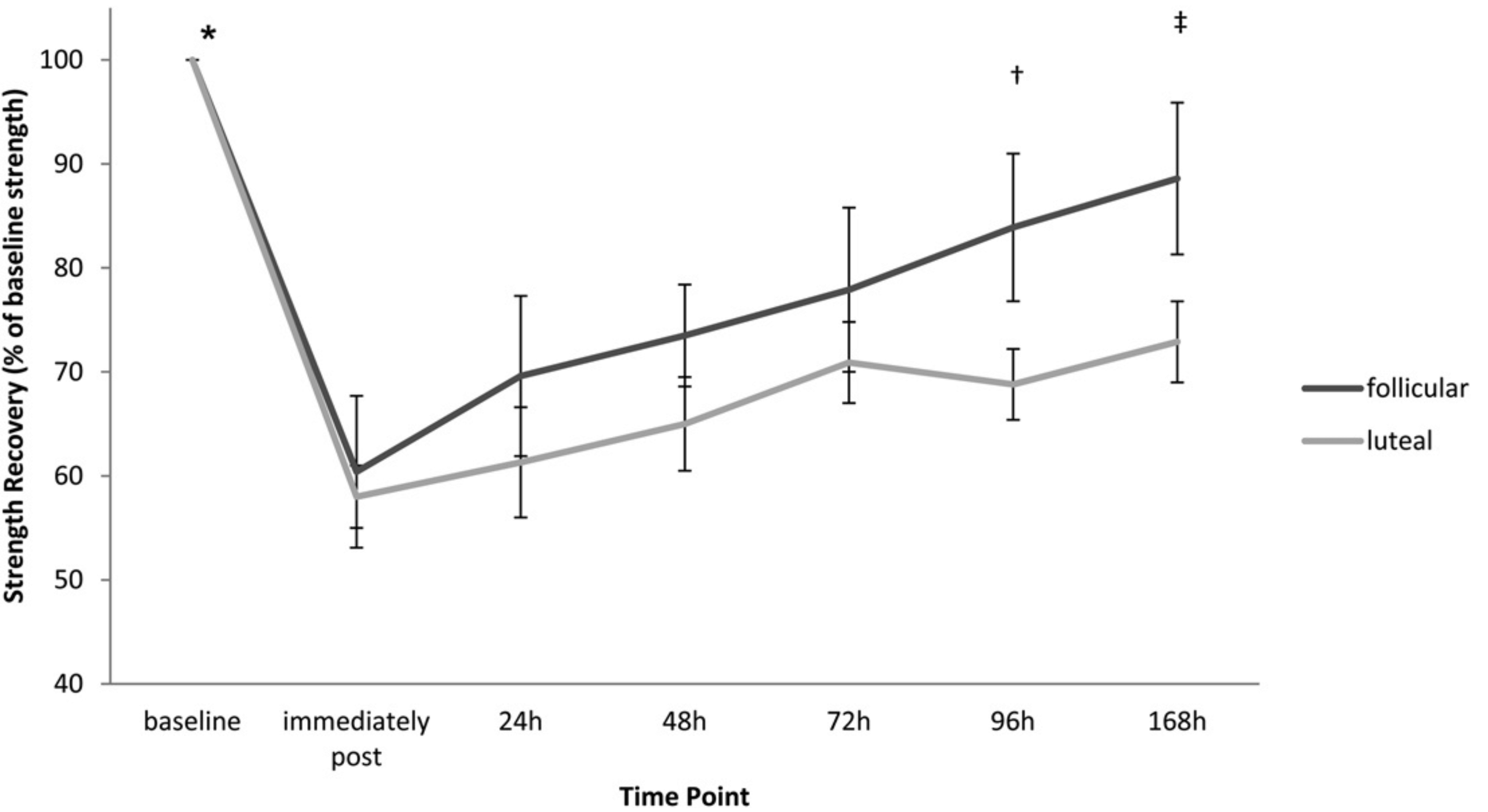
Closing Words
I hope you can take something away from this article. If you’re a woman, I hope it was illuminating and empowering. If you train women, I hope it was informative. Men and women are more alike than different when it comes to training responses, but similar doesn’t mean identical. Women are not just smaller versions of men, though they should expect the same relative rate of progress a man would.
If you got something out of this article, I’d really appreciate it if you’d share it with your friends, your gym buddies, and anyone else who you think might benefit. Since women are so underrepresented in strength training research, I find that this is a topic with so much misinformation swirling around. I hope this article can serve as a small beacon of sanity.
Addendum, July 2018: Strength Training for Women
A new study investigated male and female strength gains and hypertrophy after strength training, and I found another obscure older study that I missed in my initial sweep.
A recent study by McMahon et al. had men and women train their quads for eight weeks. Physiological cross-sectional area increased by about 23% for men and 30% for women, and knee extension torque increased by about 14% for men and 22% for women. These differences were not significant.
A 1985 study by Hunter had men and women do full-body training either three or four times per week for seven weeks. Lean body mass increased by less than a kilo in all four groups, and bench press strength increased significantly more in the group training four times per week than the group training three times per week. The male subjects increased their bench press by 11.87% and 16.69% in the groups training three and four times per week, respectively, while the female subjects increased their bench press by 19.54% and 33.33%. Strength gains were not significantly different between the sexes.
The results of these two studies are in line with the findings of this meta-analysis.
Read Next
- Sex Differences in Training and Metabolism
- The Menstrual Cycle and Contraceptives: A Complete Guide for Athletes
- Menopause and Fitness: Sex Differences, Part 3

